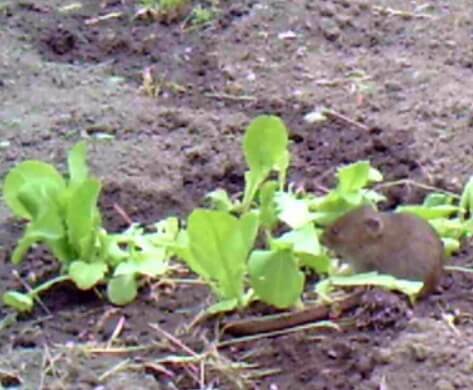Meadow Vole Eating Garden Vegetables: Video

Meadow vole eating garden lettuce.
Meadow vole (Microtus pennsylvanicus) populations typically cycle every 3-4 years, and this year is definitely a peak, at least in my backyard. The earth seems to be burping them up. To give you a sense of their abundance, I’ve seen more of them this spring than I’d seen before that, in total, in my entire life. Their holes are everywhere, and every day I catch sight of several voles darting through their runs. So when our Swiss chard and lettuce transplants disappeared within a matter of days, I suspected vole activity, but at the same time, I couldn’t imagine these tiny creatures clearing away so much so quickly. Plus, I knew that meadow voles could do substantial damage by feasting on root crops and by stripping bark to reach the nutritious cambium layer of shrubs and trees, but I had never heard of them doing serious damage to garden greens. In fact, we’ve had voles in the vegetable garden for years and years, and never experienced any significant crop damage.
No, I thought, there must be a young rabbit hiding somewhere in the garden. Our fence excludes adult cottontails and groundhogs, but on occasion in past years, a young bunny has slipped in through a small space near the gate. Well, there’s an easy way to find out, I thought. I flexed my camera trapper muscles and stationed a camera near 4 new lettuce transplants. And what I found was astonishing. Within just a few days, a vole had devastated the robust little plants by carrying off a few leaves at a time.
Meadow Vole Eating Lettuce
Watch the video and note the following:
- It’s very interesting that the vole chose to carry away most of the lettuce leaves rather than to eat them in situ. The few clips I’ve captured of these creatures eating grasses and weeds (not shown here) show it only eating in situ, and never running off with a meal. Why did it carry away the lettuce leaves? Was it caching these delicacies for a future meal, or sharing them with young? (Although I’m not sure how long the young stay with mom after weaning.)
- Interestingly, this vole harvested the lettuce only during daylight. Voles may be more active during daylight to avoid nocturnal predators when the moon is full and the night sky is clear. But we were in a half moon phase this happened. They also tend to be more active during daylight when vegetative cover allows them to eat in safety, but as you can see in the video there was little cover. I wonder if population density factors in. When numbers surge, perhaps they spread themselves out temporally. This particular vole may be active during daylight, but perhaps some of the other individuals in my garden are more active at night. If any of them were, they did not touch the lettuces.
- Voles are fast runners. The gait is actually a trot, something we don’t necessarily associate with short legged, sausage shaped creatures.
What are your thought? Have you experienced crop loss due to vole activity? Why do you think this vole harvested lettuce only during daylight? Feel free to share your comments and questions below.
Sources:
Elbroch, M. and K. Rinehart. 2011. Behavior of North American Mammals. pp. 316-321. Houghton Mifflin Harcourt Publishing Company. New York, NY.
Krebs, C. J. and J. H. Myers. 1974. Population Cycles in Small Mammals. pp. 268-389. Advances in Ecological Research, Vol. 8. Academic Press.

A busy little Furball :)) so cute!
They are cute!
Several years ago my beet crop was destroyed by Voles. It wasn’t until I started to pull the beets out of the ground that I saw they had been eaten right through the middle. I never saw any activity and the only reason I knew the damage was caused by Voles is because I contacted our local county extension office and they identified the cause. Before your video I didn’t even know what they looked like.
Yeah, they definitely do go after roots. They love Jerusalem artichokes and will cache lots of them for future consumption.
Very interesting and funny!
Glad you enjoyed it, Bob. As much as I hated to lose some of our vegetables, I couldn’t help but be amused and fascinated by these diminutive dynamos!
I just rescued one that I found walking down the middle of the street in the city with a cat close behind. He ran into my yard right passed my dog which he wasn’t afraid of. Took me 2 hrs to get it into my house and into a rabbit cage. It doesn’t have a short tail like it says. Attacks by jumping at you and hissing. Now what do I do with it? There is no way I would ever kill any creature for they all deserve to live. I think I will take it to the country and release it.